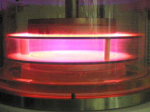argon
0
- Joined
- Jan 13, 2010
- Messages
- 72
- Points
- 8
Hi guys out there 
My second hobby are experiments with high voltage stuff (tesla coils and a lot of other hv-stuff). I would like to show you some of my vacuum high voltage experiments I made in the last few weeks.
With the following vacuum pump and a very simple high voltage generator (flyback) it is possible to perform some interesting discharge pictures.
This is the pump from ebay. It does a vacuum of about 0.05mbar under optimal conditions.

An evacuated glass bottle at relatively high pressure (bad vacuum):

A bit better vacuum:

A selfmade discharge tube (glass):

Firing up at different pressures:





After a while of using this tube, the cathode sputtered some metal vapor to the surface of the glass tube:

And another selfmade discharge tube, now a bit longer (50cm):

Thanks for looking up the thread If you are intersted in more HV-stuff, you could also visit my page www.hochspannung.ch.vu (german)
If you are intersted in more HV-stuff, you could also visit my page www.hochspannung.ch.vu (german)
Best regards
argon
My second hobby are experiments with high voltage stuff (tesla coils and a lot of other hv-stuff). I would like to show you some of my vacuum high voltage experiments I made in the last few weeks.
With the following vacuum pump and a very simple high voltage generator (flyback) it is possible to perform some interesting discharge pictures.
This is the pump from ebay. It does a vacuum of about 0.05mbar under optimal conditions.

An evacuated glass bottle at relatively high pressure (bad vacuum):

A bit better vacuum:

A selfmade discharge tube (glass):

Firing up at different pressures:





After a while of using this tube, the cathode sputtered some metal vapor to the surface of the glass tube:

And another selfmade discharge tube, now a bit longer (50cm):

Thanks for looking up the thread
Best regards
argon
Last edited:












